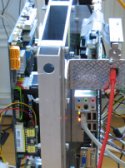Projects
This Section is for the roll up your sleeves kind of person. If you like to try things for yourself, this category is for you.
- Details
- Written by Jon Tegner
- Hits: 30056
Did you hear that? Of course not, it is my cluster.
This project was originally started as a quest for a small and
silent HTPC (Home Theater Personal Computer). We have constructed and
built several of these boxes. The latest and best design can be seen further down the page in Figure One.

These HTPC systems are cooled passively in the sense that no fans are involved in the cooling of the CPU. The technique used for the cooling turned out to be rather efficient, that is, adequate cooling can be achieved without making the system significantly larger. For instance, the HTPC shown in Figure One (below) has the dimensions 29 x 27 x 10 cm (11.4 x 10.6 x 4 inches), and even if a fan were to be used it would not be trivial to build a smaller system with the chosen components. We will say more about the design principles as they apply to personal clusters later in the article.
- Details
- Written by Joel Adams, Tim Brom, and Jeff Layton
- Hits: 306954
[Note: If you are interested in desk-side/small scale supercomputing, check out the Limulus Project and the Limulus Case]
In January 2007, two of us (professor Joel Adams and student Tim Brom) decided to build a personal, portable Beowulf cluster. Like a personal computer, the cost had to be low -- our budget was $2500 -- and its size had to be small enough to sit on a person's desk. Joel and Tim named their system Microwulf, which has broken the $100/GFLOP barrier for double precision, and is remarkably efficient by several measures. You may also want to take a look at the Value Cluster project for more information on $2500 clusters.
We wanted to mention that Distinguished Cluster Monkey Jeff Layton helped us write this article. In order to provide more than just a recipe, we also provide a discussion of the motivation, design, and technologies that have gone into Microwulf. a an aid to those that want to follow us, we also talk about some of the problems we ran into, the software we used, and the performance we achieved. Read on and enjoy!
- Details
- Written by Jeff Layton
- Hits: 32468
Jeff takes a look at what type of cluster $2500 will buy with today's technology. Back in 2005, 2.5x10E5 pennies bought eight Semprons and 14.5 GFLOPS. How many GFLOPS has two years brought us?
It's always fun to play what-if. What if I looked like Brad Pitt? What if I had lots of money? What if I lost a bunch of weight? What if I looked like Brad Pitt, lost of a bunch of weight, and had lots of money? What if I could spend that money on a new home cluster and build it myself? While worthy of an episode of Jerry Springer I think the last what-if is more appropriate for Cluster Monkey. [Men who spend their kids lunch money on Linux clusters on the next Jerry Springer Show - Ed.]
If you recall, our protagonists, Jeff and Doug, had built an 8 node cluster named Kronos for about $2,500. That was almost 18 months ago. What could we do now with $2,500? While we haven't built anything at this time, let's have a little fun and take a look at what we could build. (and what we might be building real soon now).
- Details
- Written by Angel de Vicente
- Hits: 44299
Clustering software makes it all work
In the first part of this article I showed you how to get the basic settings for our virtual cluster: we started with a fresh install of Xen; then we created five virtual machines (one master and four slaves), and then we configured the network and NFS, so that the users could share their home directories across the cluster. This is the basis for this second part of the article, in which we see how to install a number of packages that will allow us to run parallel programs on it and manage the cluster more efficiently. Concretely you will learn how to install the C3 command suite, the Modules package for easily switching environments, a version of MPICH for running parallel programs, and the Torque/Maui combination for job queue management. These packages (specially Torque/Maui) can be configured extensively according to your needs. For this virtual cluster we will use a minimal configuration, but this should be enough to get you started. If you are interested in just trying out the virtual cluster but don't want to perform all the steps yourself, you can grab a ready-made cluster image from the download:contrib:cluster page at Jailtime.org.
- Details
- Written by Angel de Vicente
- Hits: 160110
A step by step guide
It is a common practice to have development and test servers for each production server, so that you can experiment with changes without the fear of breaking anything important, but this is usually not feasible with clusters. So how do you try that new version of your favorite program before committing it to the production cluster? A cheap and convenient possibility is to build a virtual cluster.
Thanks to the Xen virtual machine monitor, you can create a number of virtual machines, all running simultaneously in your computer, install different operating systems in them, or just different configurations, and connect them via (virtual) network cards. Xen is a terrific tool for building virtual Beowulf clusters. It can prove useful when learning or teaching about clusters or for testing new features/software without the fear of causing major damage to an existing cluster.


